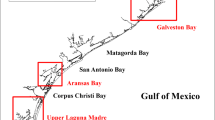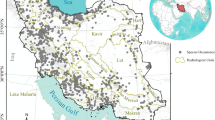Abstract
Future development and climate change pose potentially serious threats to estuarine fish populations around the world. We examined how habitat suitability for delta smelt (Hypomesus transpacificus), a state and federally protected species, might be affected by changes in outflow in the San Francisco Estuary due to future development and climate change. Forty years of sampling data collected during fall from 1967 to 2008 were examined to define abiotic habitat suitability for delta smelt as a function of salinity and water transparency, and to describe long-term trends in habitat conditions. The annual habitat index we developed, which incorporated both quantity and quality of habitat, decreased by 78% over the study period. Future habitat index values under seven different development and climate change scenarios, representing a range of drier and wetter possibilities, were predicted using a model which related estuarine outflow to the habitat index. The results suggested that each of the scenarios would generally lead to further declines in delta smelt habitat across all water year types. Recovery targets for delta smelt will be difficult to attain if the modeled habitat conditions are realized.





Similar content being viewed by others
References
Battin, J., M.W. Wiley, M.H. Ruckelshaus, R.N. Palmer, E. Korb, K.K. Bartz, and H. Imaki. 2007. Projected impacts of climate change on salmon habitat restoration. Proceedings of the National Academy of Sciences 16: 6720–6725.
Bennett, W. A. 2005. Critical assessment of the delta smelt population in the San Francisco Estuary, California. San Francisco Estuary and Watershed Science. Available at http://repositories.cdlib.org/jmie/sfews/vol3/iss2/art1.
Brekke, L. 2008. Sensitivity of future Central Valley Project and State Water Project Operations to potential climate change and associated sea level rise. US Bureau of Reclamation, Final Report. Appendix R of OCAP Biological Assessment on the continued long-term operations of the Central Valley Project and State Water Project. Available at http://www.usbr.gov/mp/cvo/ocapBA_2008.html
Brooks, T.M., R.A. Mittermeier, C.G. Mittermeier, G.A.B. da Fonseca, A.B. Rylands, W.R. Konstant, P. Flick, J. Pilgrim, S. Oldfield, G. Magin, and C. Hilton-Taylor. 2002. Habitat loss and extinction in the hotspots of biodiversity. Conservation Biology 16: 909–923.
Dettinger, M. 2005. From climate change spaghetti to climate-change distributions for the 21st century. San Francisco Estuary and Watershed Science Vol. 3, Issue 1 (March 2005), Article 4. Available at http://repositories.cdlib.org/jmie/sfews/vol3/iss1/art4.
Dobson, A., D. Lodge, J. Alder, G.S. Cumming, J. Keymer, J. McGlade, H. Mooney, J. Rusak, O. Salva, V. Woltors, D. Wall, R. Winfree, and M.A. Xenopoulos. 2006. Habitat loss, trophic collapse, and the decline of ecosystem services. Ecology 87: 1915–1924.
Draper, A.J., A. Munevar, S.K. Arora, E. Reyes, N.L. Parker, F.I. Chung, and L.E. Peterson. 2004. CalSim: Generalized model for reservoir system analysis. Journal of Water Resource Planning and Management 130: 480–489.
Feyrer, F., M. Nobriga, and T. Sommer. 2007. Multi-decadal trends for three declining fish species: Habitat patterns and mechanisms in the San Francisco Estuary, California, USA. Canadian Journal of Fisheries and Aquatic Sciences 64: 723–734.
Freeman, M.C., Z.H. Bowen, K.D. Bovee, and E.R. Irwin. 2001. Flow and habitat effects on juvenile fish abundance in natural and altered flow regimes. Ecological Applications 11: 179–190.
Good, T.P., J. Davies, B.J. Burke, and M.H. Ruckelshaus. 2008. Incorproating catstrophic rick assessments into setting conservation goals for threatened Pacific salmon. Ecological Applications 18: 246–257.
Guisan, A., T.C. Edwards, and T. Hastie. 2002. Generalized linear and generalized additive models in studies of species distributions: Setting the scene. Ecological Modeling 157: 89–100.
Hoekstra, J.M., T.M. Boucher, T.H. Ricketts, and C. Roberts. 2005. Confronting a biome crisis: Global disparities of habitat loss and protection. Ecological Letters 8: 23–29.
Jassby, A.D., W.J. Kimmerer, S.G. Monismith, C. Armor, J.E. Cloern, T.M. Powell, J.R. Schubel, and T.J. Vendlinski. 1995. Isohaline position as a habitat indicator for estuarine populations. Ecological Applications 5: 272–289.
Jones, M.A., B.J. Shuter, Y. Zhao, and J.D. Stockwell. 2006. Forecasting effects of climate change on Great Lakes fisheries: Models that link habitat supply to population dynamics can help. Canadian Journal of Fisheries and Aquatic Sciences 63: 457–468.
Kimmerer, W.J., E.S. Gross, and M.L. MacWilliams. 2009. Is the response of estuarine nekton to freshwater flow in the San Francisco Estuary explained by variation in habitat volume? Estuaries and Coasts. doi:10.1007/s12237-008-9124-x.
Kimmerer, W.J. 2002. Physical, biological, and management responses to variable freshwater flow into the San Francisco estuary. Estuaries 25: 1275–1290.
Levin, P.S., and G.W. Stunz. 2005. Habitat triage for exploited fishes: Can we identify essential “essential fish habitat?”. Estuarine, Coastal and Shelf Science 64: 70–78.
Liermann, M., and R. Hilborn. 2001. Depensation: Evidence, model and implications. Fish and Fisheries 2: 33–58.
MacKenzie, D.I. 2005. What are the issues with presence–absence data for wildlife managers? Journal of Wildlife Management 69: 849–860.
Meyer, J.L., M.J. Sale, P.J. Mulholland, and N.L. Poff. 1999. Impacts of climate change on aquatic ecosystem functioning and health. Journal of the American Water Resources Association 35: 1373–1386.
Mount, J. and R. Twiss. 2005. Subsidence, sea level rise, and seismicity in the Sacramento–San Joaquin Delta. San Francisco Estuary and Watershed Science. Vol. 3, Issue 1 (March), Article 5. Available at http://repositories.cdlib.org/jmie/sfews/vol3/iss1/art5
Moyle, P.B. 2002. Inland fishes of California. Revised and expanded. Berkeley: University of California Press.
Moyle, P.B., B. Herbold, D.E. Stevens, and L.W. Miller. 1992. Life history and status of delta smelt in the Sacramento–San Joaquin Estuary, California. Transactions of the American Fisheries Society 121: 67–77.
Newman, K. 2008. Sample design-based methodology for estimating delta smelt abundance. San Francisco Estuary and Watershed Science. Available at http://repositories.cdlib.org/jmie/sfews/vol6/iss3/art3/
Nobriga, M., T. Sommer, F. Feyrer, and K. Fleming. 2008. Long-term trends in summertime habitat suitability for delta smelt, Hypomesus transpacificus. San Francisco Estuary and Watershed Science. Available at http://repositories.cdlib.org/jmie/sfews/vol6/iss1/art1/
Perry, A.L., P.J. Low, J.R. Ellis, and J.D. Reynolds. 2005. Climate change and distribution shifts in marine fishes. Science 308: 1912–1915.
Rose, K.A., J.H. Cowan, K.O. Winemiller, R.A. Myers, and R. Hilborn. 2001. Compensatory density dependence in fish populations: Importance, controversy, understanding and prognosis. Fish and Fisheries 2: 293–327.
Schindler, D.W. 2001. The cumulative effects of climate warming and other human stresses on Canadian freshwaters in the new millennium. Canadian Journal of Fisheries and Aquatic Sciences 58: 18–29.
Service, R.F. 2007. Delta blues, California style. Science 317: 442–445.
Skreslet, S. 1986. The role of freshwater outflow in coastal marine ecosystems, NATO ASI Series G ed. Berlin: Springer
Sommer, T., C. Armor, R. Baxter, R. Breuer, L. Brown, M. Chotkowski, S. Culberson, F. Feyrer, M. Gingras, B. Herbold, W. Kimmerer, A. Mueller-Solger, M. Nobriga, and K. Souza. 2007. The collapse of pelagic fishes in the upper San Francisco Estuary. Fisheries 32: 270–277.
Stevens, D.E., and L.W. Miller. 1983. Effects of river flow on abundance of young chinook salmon, American shad, longfin smelt, and delta smelt in the Sacramento–San Joaquin River system. Transactions of the American Fisheries Society 3: 425–437.
Trexler, J.C., and J. Travis. 1993. Nontraditional regression analyses. Ecology 74: 1629–1637.
Turner, I.M. 1996. Species loss in fragments of tropical rain forest: A review of the evidence. Journal of Applied Ecology 33: 200–209.
Wilcove, D.S., D. Rothstein, J. Dubow, A. Philips, and E. Losos. 1998. Quantifying threats to imperiled species in the United States. Bioscience 48: 607–615.
Wood, C.M., and D.G. McDonald (eds.). 1997. Global warming: implications for freshwater and marine fish. Cambridge: Cambridge University Press.
Xenopoulos, M.A., D.M. Lodge, J. Alcamo, M. Marker, K. Schulze, and D. Van Vuuren. 2005. Scenarios of freshwater fish extinctions from climate change and water withdrawal. Global Change Biology 11: 1557–1564.
Acknowledgments
This study was conducted with data collected by the Interagency Ecological Program, a consortium of state and federal agencies studying the San Francisco Estuary. We thank R. Baxter, R. Breuer, M. Chotkowski, B. Herbold, P. Hrodey, A. Mueller-Solger, and K. Souza for providing support. Comments by L. Brown improved an early draft of the manuscript. The views and opinions expressed in this paper are those of the authors and do not necessarily reflect the official policy or position of their respective agencies.
Author information
Authors and Affiliations
Corresponding author
Rights and permissions
About this article
Cite this article
Feyrer, F., Newman, K., Nobriga, M. et al. Modeling the Effects of Future Outflow on the Abiotic Habitat of an Imperiled Estuarine Fish. Estuaries and Coasts 34, 120–128 (2011). https://doi.org/10.1007/s12237-010-9343-9
Received:
Revised:
Accepted:
Published:
Issue Date:
DOI: https://doi.org/10.1007/s12237-010-9343-9




